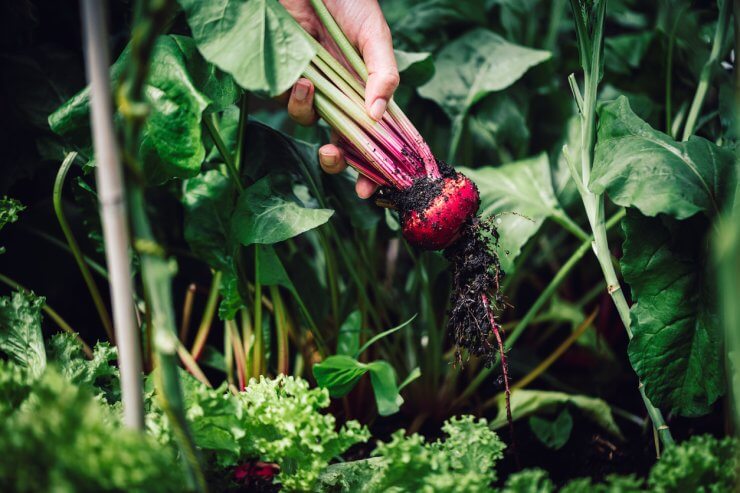
Harvesting beetroot from the garden
You can actually start enjoying your beet crop as soon as you start thinning out seedlings. The leaves are delicious and nutritious, so you can just snip them off at soil level and use them in salads, soups, or cooked like you would spinach, kale, or collards. While you’re thinning out your rows, you can also pull up the baby beets once they’re about an inch in diameter.
As you’re waiting for your beetroots to mature, you can continue to harvest some of the leaves from the plants. But only take one or two leaves at a time; remember that the leaves are the energy factory of the plant, and they need to provide energy to help the roots grow!
Check your seed packet to see how big your particular beetroots should be at harvest time. When they’re ready—you should see an inch or two of beetroot sticking up from the soil—loosen the soil around the beetroot, grab the leaves by the base of their stems, then twist and pull your beet out of the ground. If you want to reduce “bleeding” in red beets, twist off the leaves at about an inch or two from the root. Twist don’t cut; that will reduce that staining you can probably do without.
You definitely want to separate the beetroots from the leaves to stop the flow of energy between the two. Wash the leaves and store them loosely in a produce bag. Use them within two weeks.
You can store the beetroots in the fridge, too, but you must put them in airtight bags to keep moisture from seeping in. Moisture is a beet’s enemy once it’s been harvested. Use refrigerated beets within a few weeks. We discuss longer-term storage in Storing and Preserving Your Beets.
A note on harvest timing
If you’re growing a spring and fall crop, or you’re lucky enough to be able to plant a crop to grow over the winter, you’ll have to keep an eye on your plants and on your calendar. Since beets are a great candidate for succession growing, you may have plants maturing week after week. How will you keep track of what went in the ground when? We highly recommend you keep a gardener’s notebook to help you take the guesswork out of some of your harvest planning.
For a fall crop, be sure to harvest all your plants before you get a hard frost. A light frost is OK and can actually make the beets a little sweeter! Whatever you do, whenever you harvest, don’t let your plants grow much past their expected maturity date (check your seed packet). This is an example of when bigger isn’t always better. Beets that grow past their maturity date tend to become tough, fibrous, woody, soft, wrinkled—or a combination. Better to harvest a little early than too late.
Keep an eye on the leaves, too. If it’s close to harvest time and you notice the leaves are starting to wilt—that’s your warning sign to harvest your beets right away.


 Previous
Previous

